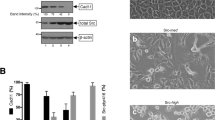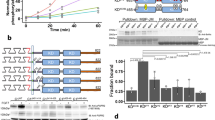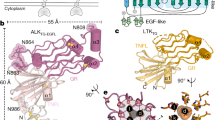Abstract
The c-Abl tyrosine (Tyr) kinase is activated after platelet-derived-growth factor receptor (PDGFR) stimulation in a manner that is partially dependent on Src kinase activity. However, the activity of Src kinases alone is not sufficient for activation of c-Abl by PDGFR. Here we show that functional phospholipase C-γ1 (PLC-γ1) is required for c-Abl activation by PDGFR. Decreasing cellular levels of phosphatidylinositol-4,5-bisphosphate (PtdIns(4,5)P2) by PLC-γ1-mediated hydrolysis or dephosphorylation by an inositol polyphosphate 5-phosphatase (Inp54) results in increased Abl kinase activity. c-Abl functions downstream of PLC-γ1, as expression of kinase-inactive c-Abl blocks PLC-γ1-induced chemotaxis towards PDGF-BB. PLC-γ1 and c-Abl form a complex in cells that is enhanced by PDGF stimulation. After activation, c-Abl phosphorylates PLC-γ1 and negatively modulates its function in vivo. These findings uncover a newly discovered functional interdependence between non-receptor Tyr kinase and lipid signalling pathways.
This is a preview of subscription content, access via your institution
Access options
Subscribe to this journal
Receive 12 print issues and online access
$209.00 per year
only $17.42 per issue
Buy this article
- Purchase on Springer Link
- Instant access to full article PDF
Prices may be subject to local taxes which are calculated during checkout








Similar content being viewed by others
References
Pendergast, A.M. The Abl family Kinases: mechanisms of regulation and signaling. Adv. Cancer Res. 85, 51–100 (2002).
Lewis, J.M., Baskaran, R., Taagepera, S., Schwartz, M.A. & Wang, J.Y.J. Integrin regulation of c-Abl tyrosine kinase activity and cytoplasmic-nuclear transport. Proc. Natl Acad. Sci. USA 93, 15174–15179 (1996).
Zipfel, P.A. et al. The c-Abl tyrosine kinase is regulated downstream of the B cell antigen receptor and interacts with CD19. J. Immunol. 165, 6872–6879 (2000).
Plattner, R., Kadlec, L., DeMali, K.A., Kazlauskas, A. & Pendergast, A.M. c-Abl is activated by growth factors and Src family kinases and has a role in the cellular response to PDGF. Genes Dev. 13, 2400–2411 (1999).
Rebecchi, M.J. & Pentyala, S.N. Structure, function and control of phosphoinositide-specific phospholipase C. Physiol. Rev. 80, 1291–1335 (2000).
Kim, H.K. et al. PDGF stimulation of inositol phospholipid hydrolysis requires PLC-γ1 phosphorylation on tyrosine residues 783 and 1254. Cell 65, 435–441 (1991).
Park, D., Min, H.K. & Rhee, S.G. Inhibition of CD3-linked phospholipase C-gamma 1 by phorbol ester and by cAMP is associated wih decreased phosphotyrosine and increased phosphoserine contents of PLC-gamma 1. J. Biol. Chem. 267, 1496–1501 (1992).
Kundra, V. et al. Regulation of chemotaxis by the platelet-derived growth factor receptor-β. Nature 367, 474–476 (1994).
Firth, J.D., Putnins, E.E., Larjava, H. & Uitto, V.J. Exogenous phospholipase C stimulates epithelial cell migration and integrin expression in vitro. Wound Repair Regeneration 9, 86–94 (2001).
Song, H. & Poo, M. Signal transduction underlying growth cone guidance by diffusible factors. Curr. Opin Neurobiol. 9, 355–363 (1999).
Yu, H., Fukami, K., Itoh, T. & Takenawa, T. Phosphorylation of phospholipase Cγ1 on tyrosine residue 783 by platelet-derived growth factor regulates reorganization of the cytoskeleton. Exp. Cell Res. 243, 112–122 (1998).
Amyere, M. et al. Constitutive macropinocytosis in oncogene-transformed fibroblasts depends on sequential permanent activation of phosphoinositide 3-kinase and phospholipase C. Mol. Biol. Cell 11, 3453–3467 (2000).
Yamamoto, M. et al. Phosphatidylinositol 4,5-bisphosphate induces actin stress-fiber formation and inhibits membrane ruffling in CV1 cells. J. Cell Biol. 152, 867–876 (2001).
Gilbert, S.H., Perry, K. & Fay, F.S. Mediation of Chemoattractant-induced changes in (Ca2+)i and cell shape, polarity, and locomotion by InsP3, DAG, and protein kinase C in newt eosinophils. J. Cell Biol. 127, 489–503 (1994).
Kadlec, L. & Pendergast, A.M. The amphiphysin-like protein 1 (ALP1) interacts functionally with the cABL tyrosine kinase and may play a role in cytoskeletal regulation. Proc. Natl Acad. Sci. USA 94, 12390–12395 (1997).
Koleske, A.J. et al. Essential Roles for the Abl and Arg Tyrosine Kinases in Neurulation. Neuron 21, 1259–1272 (1998).
Wang, Y., Miller, A.L., Mooseker, M.S. & Koleske, A.J. The Abl-related gene (Arg) non-receptor tyrosine kinase uses two F-actin binding domains to bundle actin. Proc. Natl Acad. Sci. USA 98, 14865–70 (2001).
Kain, K.H. & Klemke, R.L. Inhibition of cell migration by Abl family tyrosine kinases through uncoupling of Crk-CAS complexes. J. Biol. Chem. 19, 16185–16192 (2001).
Frasca, F., Vigneri, P., Vella, V., Vigneri, R. & Wang, J.Y. Tyrosine kinase inhibitor STI571 enhances thyroid cancer cell motile response to Hepatocyte Growth Factor. Oncogene 20, 3845–3856 (2001).
Zukerberg, L.R. et al. Cables links Cdk5 and c-Abl and facilitates Cdk5 tyrosine phosphorylation, kinase upregulation, and neurite outgrowth. Neuron 26, 633–646 (2000).
Woodring, P.J., Hunter, T. & Wang, J.Y.J. Inhibition of c-Abl tyrosine kinase activity by filamentous actin. J. Biol. Chem. 276, 27104–27110 (2001).
Diakonova, M. et al. Epidermal growth factor induces rapid and transient association of phospholipase C-γ1 with EGF-receptor and filamentous actin at membrane ruffles of A431 cells. J. Cell Sci. 108, 2499–2509 (1995).
DeMali, K.A. & Kazlauskas, A. Activation of Src family members is not required for the platelet-derived growth factor B receptor to initiate mitogenesis. Mol. Cell Biol. 18, 2014–2022 (1998).
Ji, Q., Ermini, S., Baulida, J., Sun, F. & Carpenter, G. Epidermal growth factor signaling and mitogenesis in Plcg1 null mouse embryonic fibroblasts. Mol. Biol. Cell 9, 749–757 (1997).
Smith, M.R. et al. Phospholipase C-gamma 1 can induce DNA synthesis by a mechanism independent of its lipase activity. Proc. Natl Acad. Sci. USA 91, 6554–6558 (1994).
Stolz, L.E., Kuo, W.J., Longchamps, J., Sekhon, M. & York, J.D. INP51, a yeast inositol polyphosphate Inp54 required for phosphatidylinositol 4,5-bisphosphate homeostasis and whose absence confers a cold-resistant phenotype. J. Biol. Chem. 19, 11852–11860 (1998).
Raucher, D. et al. Phosphatylinositol 4,5-bisphosphate functions as a second messenger that regulates cytoskeleton-plasma membrane adhesion. Cell 100, 221–228 (2000).
Oh, E.S., Woods, A., Lim, S.T., Theibert, A.W. & Couchman, J.R. Syndecan-4 proteoglycan cytoplasmic domain and phosphatidylinositol 4,5-bisphosphate coordinately regulate protein kinase C activity. J. Biol. Chem. 273, 10624–10629 (1998).
Ronnstrand, L. et al. Overactivation of phospholipase C-γ1 renders platelet-derived growth factor β-receptor expressing cells independent of the phosphatidylinositol 3-kinase pathway for chemotaxis. J. Biol. Chem. 274, 22089–22094 (1999).
Pendergast, A.M. et al. Evidence for regulation of the human Abl tyrosine kinase by a cellular inhibitor. Proc. Natl Acad. Sci. USA 88, 5927–5931 (1991).
Ivan, M. et al. HIFalpha targeted for VHL-mediated destruction by proline hydroxylation: implications for O2 sensing. Science 20, 464–9 (2001).
Goga, A. et al. Oncogenic activation of c-Abl by mutation within its last exon. Mol. Cell Biol. 13, 4967–4975 (1993).
Furstoss, O. et al. c-Abl is an effector of Src for growth factor-induced c-myc expression and DNA synthesis. EMBO J. 21, 514–524 (2002).
Mayer, B. & Baltimore, D. Mutagenic analysis of the roles of SH2 and SH3 domains in regulation of the Abl tyrosine kinase. Mol. Cell Biol. 14, 2883–2894 (1994).
Brasher, B.B. & Van Etten, R.A. c-Abl has high intrinsic tyrosine kinase activity that is stimulated by mutation of the Src homology 3 domain and by autophosphorylation at two distinct regulatory tyrosines. J. Biol. Chem. 275, 35631–35637 (2000).
Van Etten, R.A. Cycling, stressed-out and nervous: cellular functions of c-Abl. Trends Cell Biol. 9, 179–186 (1999).
Barila, D. & Superti-Furga, G. An intramolecular SH3-domain interaction regulates c-Abl activity. Nature Genet. 18, 280–282 (1998).
Jackson, P. & Baltimore, D. N-terminal mutations activate the leukemogenic potential of the myristoylated form of c-Abl. EMBO J. 8, 449–456 (1989).
Pluk, H., Dorey, K. & Superti-Furga, G. Autoinhibition of c-Abl. Cell 108, 247–259 (2002).
Cong, F. et al. Cytoskeletal protein PSTPIP1 directs the PEST-type protein tyrosine phosphatase to the c-Abl kinase to mediate Abl dephosphorylation. Mol. Cell 6, 1413–1423 (2000).
Echarri, A. & Pendergast, A.M. Activated c-Abl is degraded by the ubiquitin-dependent proteasome pathway. Curr. Biol. 11, 1759–1765 (2001).
Gallo, G. & Letourneau, P.C. Axon guidance: A balance of signals sets axons on the right track. Curr. Biol. 9, R490–R492 (1999).
Osborne, S.L., Meunier, F.A. & Schiavo, G. Phosphoinositides as key regulators of synaptic function. Neuron 32, 9–12 (2001).
Irvin, B.J., Williams, B.L., Nilson, A.E., Maynor, H.O. & Abraham, R.T. Pleiotropic contributions of phospholipase C-γ1 (PLC-γ1) to T-cell antigen receptor-mediated signaling: reconstitution studies of a PLC-γ1-deficient Jurkat T-cell line. Mol. Cell Biol. 20, 9149–9161 (2000).
Valius, M., Bazenet, C. & Kazlauskas, A. Tyrosines 1021 and 1009 are phosphorylation sites in the carboxy terminus of the platelet-derived growth factor receptor beta subunit and are required for binding of phospholipase C gamma and a 64-kilodalton protein, respectively. Mol. Cell Biol. 13, 133–143 (1993).
Williams, B.L. et al. Phosphorylation of Tyr319 in ZAP-70 is required for T-cell antigen receptor-dependent phospholipase C-γ1 and Ras activation. EMBO J. 18, 1832–1844 (1999).
Acknowledgements
This work was supported by NIH grants CA70940 and GM62375 to A.M.P., NIH training grant CA09111-25 to R.P., National Institute of Health grant GM47286 to R.T.A., Howard Hughes Medical Institute funding to J. T. Y, and funded in part by GlaxoSmithKline. We thank G. Carpenter (Vanderbilt University, Nashville, TN) for the PLC-γ1 null fibroblasts, R.Van Etten (Harvard Medical School, Boston, MA) for c-Abl constructs, T. Pawson (Samuel Lunenfeld Research Institute, Mount Sinai Hospital, Toronto, Canada) for GST–PLC-γ1 fusion proteins, and A. Koleske (Yale University, New Haven, CT) for Abl/Arg null MEFs. We thank S. Finn and P. Zipfel (Duke University) for critically reading the manuscript, J. Stevensen-Paulik and A. Seeds (Duke University) for help in running the HPLC, and M. Calera (Harvard Medical School) for the PAE/PDGFR-β cell line.
Author information
Authors and Affiliations
Corresponding author
Ethics declarations
Competing interests
The authors declare no competing financial interests.
Rights and permissions
About this article
Cite this article
Plattner, R., Irvin, B., Guo, S. et al. A new link between the c-Abl tyrosine kinase and phosphoinositide signalling through PLC-γ1. Nat Cell Biol 5, 309–319 (2003). https://doi.org/10.1038/ncb949
Received:
Revised:
Accepted:
Published:
Issue Date:
DOI: https://doi.org/10.1038/ncb949
This article is cited by
-
Combating acquired resistance to MAPK inhibitors in melanoma by targeting Abl1/2-mediated reactivation of MEK/ERK/MYC signaling
Nature Communications (2020)
-
Enabling Tumor Growth and Progression: Recent Progress in Unraveling the Functions of ABL Kinases in Solid Tumor Cells
Current Pharmacology Reports (2018)
-
Atomic view of the energy landscape in the allosteric regulation of Abl kinase
Nature Structural & Molecular Biology (2017)
-
The NESH/Abi-3-based WAVE2 complex is functionally distinct from the Abi-1-based WAVE2 complex
Cell Communication and Signaling (2015)
-
The Ron receptor tyrosine kinase activates c-Abl to promote cell proliferation through tyrosine phosphorylation of PCNA in breast cancer
Oncogene (2014)



